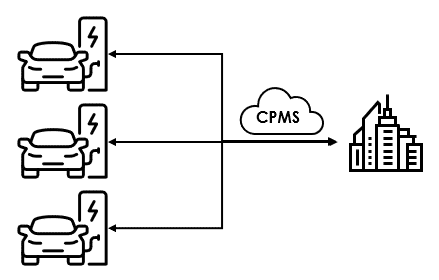Vehicle-to-Building (V2B) systems represent a transformative approach to energy management by enabling electric vehicles (EVs) to function as decentralized energy storage units during idle periods. This technology allows EV owners to monetize their vehicles' downtime by supplying excess energy to commercial or residential buildings, particularly during peak demand hours. Key advantages include:
- Economic Benefits : V2B creates dual revenue streams—EV owners earn through energy sales, while buildings reduce reliance on grid electricity.
- Grid Stability : By balancing supply-demand mismatches, V2B alleviates grid stress and lowers infrastructure upgrade costs.
- Sustainability : Integrating EVs into energy systems accelerates renewable adoption and reduces carbon footprints.
1. What is V2B and Why It’s a Game-Changer?
The average electric vehicle (EV) sits idle for 23 hours a day. What if those parked hours could generate revenue? Enter Vehicle-to-Building (V2B) systems – a technology allowing EVs to power buildings during peak demand, turning idle batteries into profit centers.
How It Works:
- Bidirectional Chargers: Unlike standard EVSE, V2B-enabled chargers (e.g., ABB Terra DC Wallbox) reverse energy flow using ISO 15118-20 protocol.
- Energy Arbitrage: Buy low-cost off-peak energy, sell back to buildings during peak rates – a 15-30% ROI boost reported by Schneider Electric case studies.
Why Now?:
- Grid Pressures: California’s 2024 “Flex Alert” programs pay $0.50/kWh for V2B energy discharge during shortages.
- Corporate ESG Goals: Walmart’s 2025 target to slash facility emissions by 50% relies on V2B fleets.
2. Real-World Applications: Who Benefits Most?
Case Study 1: Logistics Fleets
- Problem: A FedEx depot in Texas faced $12,000/month demand charges during 4-7 PM peaks.
- Solution: Deployed 50 V2B-capable BrightDrop vans, discharging 250kW to the warehouse.
- Result: 22% lower energy costs, with additional $2,800/month income from grid services.
Case Study 2: Office Buildings
- Google’s Mountain View Campus uses 150 employee EVs as “virtual power plants”, reducing backup generator dependency by 40%.
Top Beneficiaries:
- Urban Data Centers: Offset 10-15% energy needs via nearby EV parking.
- Retail Chains: Target’s “Charge & Save” program offers discounted shopping in exchange for V2B participation.
3. Step-by-Step Guide to Implementing V2B

Step 1: Assess Feasibility
- Use tools like Energy Toolbase to model:
Annual Profit = (Peak Rate - Off-Peak Rate) × Discharge Capacity × Utilization Days
Example:
-
Peak Rate: $0.35/kWh (PG&E Summer Rates)
- Discharge: 100 EVs × 50kWh/day = 5,000 kWh/day
- Annual Profit: (0.35−0.12) × 5,000 × 250 = $287,500
Step 2: Hardware Selection
-
Must-Haves:Bidirectional Chargers: ChargePoint Express Plus (CCS-1), Wallbox Quasar (J1772)
- Energy Management Systems (EMS): Tesla Virtual Power Plant (VPP) software
Step 3: Compliance & Safety
-
Standards:UL 9741 (V2B System Safety)
- SAE J3072 (Grid Interconnection)
- Cybersecurity: Enable TLS 1.3 encryption for OCPP 2.0 communications.
4. Overcoming Challenges
Despite its potential, widespread V2B adoption faces hurdles:
Technical Limitations : Battery degradation concerns and lack of standardized bidirectional charging protocols hinder scalability.
- Regulatory Barriers : Outdated policies often fail to address V2B-specific issues like tariff structures and liability frameworks.
- Market Awareness : Low stakeholder awareness about V2B’s long-term ROI limits participation.
Challenge 1: Battery Wear Concerns
- Solution: Limit discharge depth to 80% – proven by Nissan Leaf studies to reduce degradation to 1.5%/year vs. 2.8% with full cycles.
Challenge 2: Regulatory Hurdles
- Best Practice: Partner with utilities like Con Edison’s V2B Pilot Program to bypass red tape.
Challenge 3: User Adoption
- Incentive Design: Offer drivers $0.10/kWh rebates – used by Ford Pro’s “Intelligent Backup Power” to achieve 85% opt-in rates.
To maximize V2B’s potential, stakeholders should:
- Technology Adaptation : Develop AI-driven platforms to optimize energy pricing and EV-battery health monitoring.
- Policy Incentives : Governments could introduce tax rebates for V2B participants and update grid interconnection standards.
- Consumer Education : Launch pilot projects demonstrating V2B’s reliability and profitability through real-world use cases.
5. Future Trends
As smart grids and renewable energy penetration grow, V2B will evolve from a niche solution to a core component of urban energy ecosystems. Innovations like blockchain-based energy trading and vehicle-to-everything (V2X) integration will further solidify its role in achieving net-zero targets.
1. V2X Integration: Turn EVs into Revenue-Generating Assets
While most suppliers focus on basic charging, our patented V2X platform (Vehicle-to-Everything) enables:
Hybrid V2B+V2G Operation
Power supply to buildings during the day (V2B) and participation in grid frequency modulation at night (V2G)
AI-Powered Energy Routing
Dynamic selection of the highest revenue scenario (tariff difference/subsidy policy)
Why Choose Us?
1.Support ISO 15118-20 plug-and-play charging, compatible with mainstream models such as Tesla/BYD
2. AI-Driven Predictive Maintenance: Zero Downtime, Maximum Profit
Traditional maintenance wastes 17% of potential revenue (Deloitte data). Our solution:
- Failure Prediction 72h in Advance
There is no significant difference between the two groups(P> 0.05)
- Self-Healing Firmware
80% of software problems are automatically fixed without manual intervention
3.Provide real-time health dashboard, improve operation and maintenance efficiency by 4 times
4.Global Standard Compliance: One-Stop Access to 40+ Markets
- Modular Certification Kit
Core module pre-certification (CE/UL/UKCA/KC, etc.), adaptation localization shell can quickly go to market
Speed comparison: Traditional 6-8 months → We average 2.3 months
- Real-Time Regulation Updates
We’ve deployed 50+ V2B projects globally, cutting clients’ energy costs by up to 30% through intelligent idle-time energy trading.From feasibility analysis to ROI optimization, our team handles technical, regulatory, and financial complexities for you.Our AI-driven platform adapts to your building’s load patterns and regional energy policies in real time.
Don’t let idle EVs drain value – turn downtime into revenue TODAY.
Post time: Feb-10-2025



